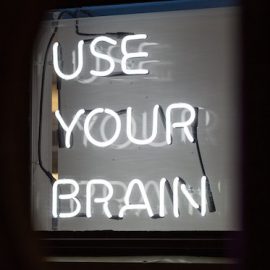

This article is an excerpt from the Shortform book guide to "Scattered Minds" by Gabor Maté. Shortform has the world's best summaries and analyses of books you should be reading.
Like this article? Sign up for a free trial here.
What does ADHD look like? What are the primary symptoms of ADHD?
Scattered Minds by Gabor Maté explains that if you have ADHD, you experience at least two of three primary symptoms: difficulty with attention, difficulty with impulse control, and difficulty with stillness. You may also struggle with secondary symptoms, including difficulty with self-esteem and difficulty with relationships.
Let’s explore each of the symptoms in detail.
Difficulty With Attention
What does ADHD look like in adults and children? If this is the case for you, you’re unable to focus on what you’re doing unless you’re already highly motivated to do it. For example, you might find it easy to get into the zone when you’re working on a hobby but feel unable to pay attention to activities you don’t enjoy, like your taxes. Maté says that this can lead you to procrastinate on things you don’t enjoy until the time crunch motivates you to focus and take action, which can stress you out and prevent you from achieving your goals.
(Shortform note: Girls and women with ADHD tend to struggle more with attention regulation than they do with the other symptoms of ADHD. Compared with hyperactivity and a lack of impulse control, inattentiveness can be subtle—for example, a teacher is less likely to take notice when a student is quietly daydreaming during class and more likely to notice that a student often gets up to talk to their friends in the middle of class. Experts believe that this contributes to the underdiagnosis of ADHD in girls and women.)
Difficulty With Impulse Control
If you have difficulty with impulse control, you act on your first instinct without thinking about the consequences of your actions. For example, Maté says that you might feel unable to stop yourself from frequently interrupting others instead of waiting your turn to speak. You may also feel like you have to do or get what you want right now—even if it’s not in your best interest.
(Shortform note: One serious consequence of a lack of impulse control is increased engagement in risky behaviors—like dangerous driving, substance abuse, unprotected sex, and even crime. Research suggests that people with ADHD are more likely to take risks like these because they’re inclined to see the potential benefits of the behavior more clearly than the potential pitfalls.)
Difficulty With Stillness
If you have difficulty with stillness, you simply can’t tolerate inactivity, so you’re always in motion. You may stay physically still for long periods of time—like when you’re procrastinating on a work assignment—but that stillness isn’t restful; the whole time, you’re thinking about the other things you need to be doing. Maté says that this often presents as anxiety—you’re not merely active, you’re restless and worried.
(Shortform note: The way this symptom manifests may change from childhood to adulthood. While children typically demonstrate physical hyperactivity, adults tend to exhibit mental hyperactivity. Some experts attribute this change to masking—as you grow up, you learn that physical hyperactivity is inappropriate, so you pretend to be calm on the outside although your mind continues to race on the inside.)
Secondary ADHD Symptoms
You may also have secondary symptoms, like difficulty with self-esteem and relationships. Maté explains that you only experience these secondary symptoms because your primary symptoms adversely impact the way you interact with the world.
You might have difficulty with self-esteem if your ADHD symptoms have interfered with your ability to achieve your goals. For example, Maté notes that difficulty with attention can contribute to poorer memory that may affect your performance at work and derail your career. Not doing as well as you’d like to may lead you to feel inadequate.
(Shortform note: Research suggests that the stigma associated with ADHD is one of the main drivers of low self-esteem in people with ADHD. Many people believe that ADHD isn’t a legitimate diagnosis—they mistakenly attribute your symptoms to laziness or stupidity, which makes them highly critical of even your best efforts and more likely to reject you. To protect your self-esteem, dispel the stigma: Assertively educate the misinformed that ADHD is a real condition and how it truly affects you.)
You might have difficulty with relationships if your ADHD symptoms make it hard for you to follow social rules or meet others’ standards. For example, Maté notes that difficulty with impulse control can result in emotional outbursts—in a conflict, you might say the first thing that comes to mind, even if it isn’t kind or constructive, which intensifies the conflict and ultimately distances you from others.
(Shortform note: Even those without ADHD may struggle to keep their emotions in check. If you’re prone to emotional outbursts, neuroscientist and psychologist Lisa Feldman Barrett recommends three measures to increase your emotional control in her book How Emotions Are Made: First, take good physical care of yourself—you’re more likely to lose emotional control when you don’t feel good. Second, improve your emotional granularity—if you can distinguish the fine differences between your many emotions, it’ll be easier to understand your feelings and how to handle them. Third, recategorize your emotions—for example, you might re-interpret your anger about a conflict as enthusiasm to get on the same page as your partner.)

———End of Preview———
Like what you just read? Read the rest of the world's best book summary and analysis of Gabor Maté's "Scattered Minds" at Shortform.
Here's what you'll find in our full Scattered Minds summary:
- How ADHD is caused by early childhood stress that hinders development
- Why medication isn't the best way to treat ADHD
- How society can prevent ADHD in future generations






